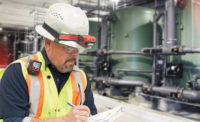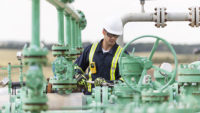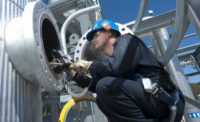H2O2 gas detectors are critical after VPH

The coronavirus pandemic has changed the way we look at indoor spaces. The virus can easily spread in schools, hospitals, office buildings, confined areas, and those with poor ventilation. Bacteria containing the virus can live on inanimate surfaces for up to 72 hours. When bringing workers onsite, business owners and managers need to make sure the interior is free of bacteria that could lead to the spread of the virus.
The VPH process
Many business owners will use vaporized hydrogen peroxide (VPH) to disinfect various work environments, particularly those that are designed for prolonged human occupancy. This is one of the fastest and most reliable ways to decontaminate indoor areas.
To administer the VPH, safety professionals will use a generator to first dehumidify the area in question. The machine will then send aqueous vaporized hydrogen peroxide over a vaporizer to distribute the chemical throughout the air. The generator will circulate the VPH based on the user’s desired concentration. During this time, the vaporized mist will kill coronavirus bacteria in a matter of seconds. The generator will then suck up as much VPH as possible to return the space to its original condition.
This is often much more efficient and reliable than wiping down individual surfaces with disinfectant wipes. Every surface in the room will be treated with the same chemicals for lasting protection and peace of mind. VPH is a common choice for those that need to decontaminate large spaces as quickly as possible. It’s also a good choice for spaces that need to be treated regularly; however, managers need to get in the habit of checking for any VPH that may be lingering in the air.
The dangers of hydrogen peroxide
Using VPH in the workplace can be a hazard to employees if it’s not fully removed from the area either by being vented to the outside air or recaptured. According to the Centers for Disease Control and Prevention, workers exposed to vaporized hydrogen peroxide may suffer from respiratory irritation, sore throat, watery eyes, skin irritation, and internal organ damage. VPH is a safe, reliable way to remove disease-causing bacteria, but employees need to make sure the area is free from hydrogen peroxide before bringing their employees back onsite.
Hydrogen peroxide is a colorless, odorless gas that can be nearly impossible to detect without an H202 gas monitor. Employers can use these gas detectors to make sure the work environment is safe for human occupancy once the space has been treated with VPH.
Using H202 gas monitors
A manager or safety inspector should install an H202 monitor inside the office or work area to prevent possible exposure to hydrogen peroxide. The monitor will issue an alarm if there is too much VPH in the air. The employer can then take additional steps to air out the work environment before bringing workers back into the building, such as installing air filters or opening the window.
The manager can then use the gas detector to make sure the VPH has been removed from the area in question, so their workers can return to the office with more peace of mind.
Workers can also use wearable, portable H202 gas monitors when entering a confined space or working in the field. This is a great choice for first responders, utility workers, and maintenance crews. The monitor clips right onto their belt or hand held while keeping on the job. The monitor will issue a warning when there is too much hydrogen peroxide in the air, so the person can either put on a respirator or leave the contaminated area as quickly as possible.
Vaporized hydrogen peroxide can easily linger in corners, confined spaces, and other poorly ventilated areas. Managers should install a series of detectors in the space if they have a lot of room to cover. This ensures all areas are safe for human occupancy.
Businesses will need to keep records of their safety information as we continue to live with this virus. If an infection or injury should occur, the owner will have to prove they did everything they could to prevent the spread of the coronavirus, while keeping their workers safe from hydrogen peroxide. H202 gas monitors with built in data logging help business owners stay on top of this important safety information.
Getting used to the coronavirus
Running a business in the age of COVID-19 has been a challenge for many businesses and organizations. Managers now find themselves having to deal with a range of hazards and health concerns they never thought possible. VPH can help business owners resume their operations as quickly as possible after a possible outbreak or long periods of limited activity. It’s a highly efficient and cost-effective way to decontaminate the workplace regularly.
However, using VPH requires additional safety measures. Installing H202 monitors is an easy way to prevent possible exposure to hydrogen peroxide. Workers can go about their business without having to worry about getting infected with the coronavirus or breathing in particles that could be hazardous to their health. Managers can also quickly disinfect their property without leaving anything to chance.
Companies should choose H202 monitors based on the nature of their workplace and the job at hand. If workers are constantly moving from one location to another, it’s best to go with wireless, portable gas monitors. Installing monitors on the wall is a great choice for offices, conference rooms, and meeting places. Preventing the spread of the coronavirus has become top-of-mind for many business owners, but they can’t afford to overlook the dangers of hydrogen peroxide.
H202 monitors have an important role to play as various industries try to resume their operations. We’re still a long way from putting this virus to bed. Until then, everyone should be able to earn a living and go to work without fearing for their health and safety.
Looking for a reprint of this article?
From high-res PDFs to custom plaques, order your copy today!





